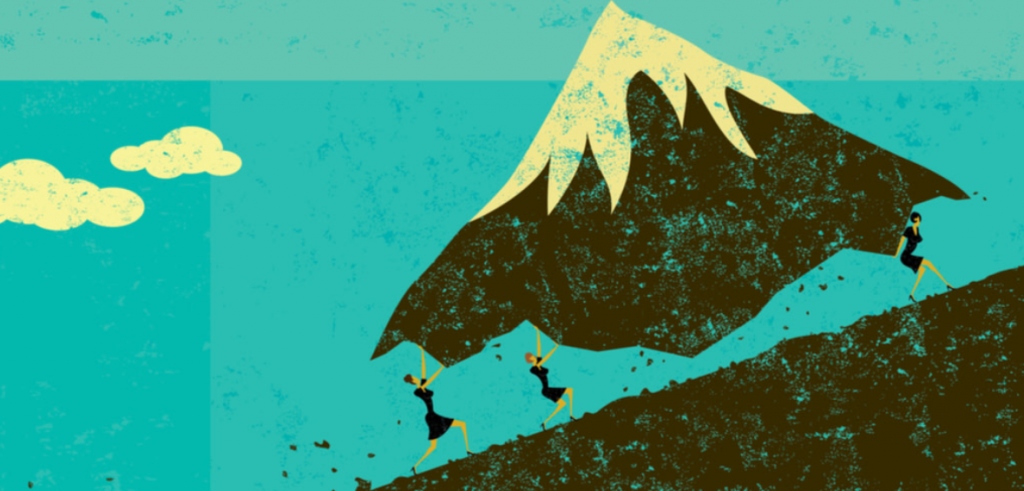
Printed on the front of my favorite college T-shirt is a huge triangular mountain with people in pastel skirts and pants, holding hands around the base of the mountain. The mountain and the people are sketched lightly in pencil, expressing movement. The people and the mountain are in motion. The message is wordless but the symbolism is unmistakable. The people may be singing and dancing or peacefully silent, but together, they are clearly moving this mountain. Although I loved the T-shirt, for many years the message eluded me. It didn’t make sense. How could people move a mountain?
The common phrase “moving mountains” continued to puzzle me until a couple of months ago when I asked a question about the meaning of ‘shapeshifting’. If you ask anyone between the age of two and 20, they’ll tell you immediately what shapeshifting is — it is the ability to transform oneself, to change from one shape to another, the way Superheroes do. Shapeshifters remove obstacles and barriers. Why hadn’t I understood this before? Moving a mountain seems daunting and impossible, especially for mere mortals. Yet, the idea of mountain movers resonates. The difference between the two phrases lies in a sense of agency. Mountain movers are actively engaged in a process of change, busily transforming themselves and tackling obstacles that lie in their way.
Seen through this lens, mountain movers appear everywhere. For example, the winners of the Smithsonian’s Ingenuity Awards for 2019. American rapper, singer and songwriter Lil Nas X hit the top of the 2019 Billboard Chart with his song “Old Town Road.” In addition, he received the Ingenuity Award for his wizard-like use of social media to make himself known. When Lil Nas X became embroiled in racial controversy about whether his rap song deserved to be called “country”, he teamed with Billy Ray Cyrus, a veteran country musician and hit the top of the charts a second time. Nominated for six Grammy Awards, he won for Best Music Video and Best Pop Duo/Group Performance. Two other Ingenuity Award winners, Dr. Ewelina Mamcarz, a pediatric hematologist-oncologist, and Dr. Stephen Gottschalk, Chair of the Department of Bone Marrow Transplant and Cellular Therapy at St Jude Children’s Research Hospital, worked together with their team to develop a stem cell procedure to produce the immune system components needed to fight infections in patients with X-linked severe combined immunodeficiency (SCID) or “bubble boy disease.” This team of mountain movers used their engineering skills to tackle the complexities and uncertainties of the genetic frontier.
Lil Nas X, Dr. Mamcarz and Dr. Gottschalk are the Superheroes of mountain moving. What about the rest of us? Each of us has what it takes to be a mountain mover. I recently experienced a mountain-moving moment when asked to edit a professional newsletter. Initially, it seemed like a herculean task. The editor of the professional newsletter asked me to join her as an assistant editor after reading some blogs that I’d written and noticed that I enjoy writing. While agreeing with her that I do like to write, my initial response was “No!” Too many obstacles lay in my way. Editing was a skill I simply didn’t have. How could I transform myself from a creative writer to a technical one? It was easy to talk myself out of it. Why try? It would be far too difficult. Fortunately, when the editor nudged me again, I understood her request not as “moving a mountain” (doing the impossible) but as an invitation to join her in an ACTIVE PROCESS. Could I become a mountain mover, learn a new skill, expand my knowledge and welcome a challenge? The editor seemed to have confidence in me and gave me the courage to look in the mirror and see potential that I did not yet recognize in myself.
Becoming a mountain mover is easier when a person receives support from others. The “other” may be a friend, a mentor, a colleague, a parent. Not only do others lend general support, at times they help us see ourselves with a broader perspective, more expansively than we can see ourselves. We look in their mirror and see it reflecting our better selves. When general support is not enough to make the mountain move, working with a therapist may be helpful. Since it is part of a therapist’s responsibility to be non-judgmental, unless you are putting yourself in a highly risky situation or relationship, a therapist’s role is to facilitate change. The changes are ones you want to make, and a therapist can help you become a mountain mover even when the obstacles before you seem insurmountable. Sometimes, the mountain and its movement represent internal conflict. One’s internal dialogue goes something like this: “There is nothing I can do, the mountain is too big. I can’t change!” vs. “I can do this. I will make it happen!” The contrast between the two perspectives represents the difference between a lack of personal agency and a sense of personal agency, possibility and hope. Many of my patients carry this tension. One’s own barriers get in the way of emotional growth. Yet, delving into one’s personal life and understanding how the past and present influence how we currently think, feel and communicate can be messy and confusing. While ultimately rewarding, it may be a difficult journey. So why go it alone?
A long time ago, I traveled to Ayers Rock in the middle of Australia by myself. Ayers Rock is impressive; a red half-moon mountain on a flat desert backdrop. The rock is steep and signs warn hikers about the slickness of its surface and the importance of holding onto the chain while climbing to the summit. Yet, it is not reaching the top of the mountain that stands out in my memory. It is walking around the base, hugging the rock for shade, wondering how much further I needed to walk to get back to the visitors’ center. Was I trying to figure out the secret of how to move a mountain? Hard to recall. What I do remember are the flies and the heat, the dry, crimson sand, my lack of water, and the stillness around me. It was sacred, yet lonely. In my fierce independence, I didn’t realize that it would have been easier, more educational and fun to walk the base with a guide. What I did not know then is the secret of Superheroes and ordinary mountain movers; they not only tap a force within themselves and wear the cape of personal agency, they surround themselves with supportive others, ever ready and present to help them tie on their cape and watch them soar.




